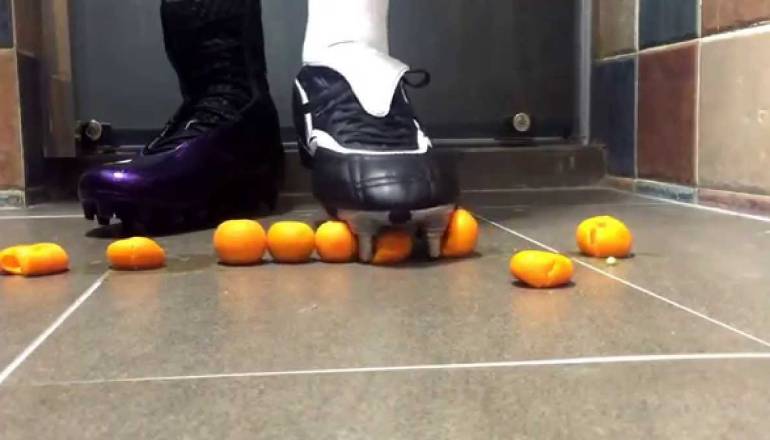Which Is Better for You? Rugby Cleats vs Soccer Cleats
Rugby cleats and soccer cleats may look similar, but they are actually quite different. Rugby cleats have six studs on the bottom, while soccer cleats have only four. This gives rugby cleats more traction on the field, which is important for a sport that involves a lot of running and tackling. Soccer cleats also have a smaller toe box than rugby cleats, which allows for more precise control of the ball.
Rugby and soccer are two very popular sports. Each has its own unique style of play. Each requires a different type of cleat. In this article, we’ll take a look at the differences between rugby cleats and soccer cleats, and help you decide which is right for you.
What’s the Difference Between Soccer and Rugby Cleats?
When it comes to choosing the right cleats for your sport, it’s important to know the difference between soccer and rugby cleats. Both sports require different types of footwear to provide the best possible grip and support on the playing surface. Here’s a quick rundown of the main differences between soccer and rugby cleats.
Soccer cleats tend to be lighter and have smaller spikes, while rugby cleats are heavier and have larger spikes. This is because soccer is typically played on softer surfaces, like grass, while rugby is played on harder surfaces, like turf. Soccer cleats also have a rounder toe, while rugby cleats have a more pointed toe. Finally, soccer cleats typically have softer leather, while rugby cleats have tougher leather. Soccer cleats usually have removable insoles, while rugby cleats typically do not.
Soccer Cleats
Soccer cleats are designed to provide traction and stability on firm, natural surfaces like grass. They typically have 12-16 studs that are evenly distributed across the bottom of the shoe. The length and configuration of the studs can vary depending on the position you play. For example, midfielders and forwards often prefer shorter, blunter studs that offer good traction for quick starts and stops. Defenders tend to prefer longer studs that offer more stability when making tackles or blocking shots.
Rugby Cleats
Rugby cleats are designed for use on soft, natural surfaces like grass or mud. They typically have 6-12 studs that are longer and more pointed than those found on soccer cleats. This design provides good traction for running, cutting, and changing direction quickly. Rugby cleats also often have a raised heel to help prevent ankle injuries when scrumming or rucking.
So, when it comes time to buy cleats, be sure to choose the right type for your sport. Soccer cleats will not provide the same level of traction and stability as rugby cleats, and vice versa. With the right pair of cleats, you’ll be able to perform your best out on the field!
Is It Ok to Wear Soccer Cleats for Rugby?
You might be able to get away with wearing soccer cleats for rugby, but it’s not ideal. Soccer cleats are designed for playing on grass, while rugby is played on a much rougher surface. This means that you’re more likely to slip and fall when wearing soccer cleats on a rugby pitch. You’re also likely to damage the cleats themselves since they’re not built to withstand the wear and tear of rugby. If you can, it’s best to invest in a pair of cleats specifically designed for rugby.
If you’re playing on grass, then any type of soccer cleat will be fine. However, if you’re playing on a hard surface like concrete or artificial turf, then you’ll want to make sure you have the right type of cleat. Soccer cleats that are made for hard surfaces have smaller studs that are designed to provide traction without damaging the playing surface.
So, if you’re planning on playing rugby on a hard surface, make sure you get the right type of soccer cleat. Otherwise, any type of soccer cleat will do just fine.
What Kind of Shoes do You Wear for Rugby?
There are a few different types of shoes that you can wear for rugby. For example, you could wear cleats, turf shoes, or even running shoes. It really depends on what type of surface you’ll be playing on and what kind of traction you need.
If you’re playing on a grass field, cleats are a good option. They’ll give you the traction you need to make quick cuts and changes in direction. Turf shoes are also a good choice for grass fields. They have smaller cleats that will provide good traction without tearing up the turf.
If you’re playing on an artificial turf field, turf shoes are the way to go. They have specialty cleats that are designed to grip the synthetic surface.
Running shoes are also an option on artificial turf. Some people prefer them because they’re lighter and more comfortable than cleats. No matter what type of shoe you choose, make sure it’s comfortable and fits well.
You don’t want your feet slipping around inside your shoes while you’re playing. And remember, you can always change shoes if you need to during the game. So don’t be afraid to experiment until you find the perfect pair for you.
Do you Need Special Cleats for Rugby?
Rugby is a sport that requires a lot of running, jumping, and tackling. As such, having the right footwear is essential to playing the game safely and effectively. While you don’t need special cleats for rugby, wearing cleats that are designed for other sports can increase your risk of injury. Wearing cleats that are too small can also be dangerous. Make sure to try on cleats before you buy them to ensure a good fit.
If you’re new to rugby, or if you’re just looking for a new pair of cleats, there are a few things to keep in mind. First, consider what type of surface you’ll be playing on most often. If you’ll be playing on grass, look for cleats with longer studs that will provide good traction.
If you’ll be playing on artificial turf, look for shorter studs that won’t get caught in the turf.
Second, think about the style of play you prefer. If you’re more of a speedster, look for lighter cleats that won’t weigh you down. If you’re more of a power player, look for sturdier cleats that will support your weight when you make contact with another player.
Finally, don’t forget to break in your new cleats before you hit the rugby field. Wear them around the house or during practice to help them mold to your feet and prevent blisters. With these tips in mind, you’ll be sure to find the perfect pair of rugby cleats for your needs.
Final Remarks
Rugby cleats and soccer cleats both have their pros and cons, so it really depends on your individual needs as to which type of cleat you should buy. If you’re looking for a cleat that will provide more ankle support, then a rugby cleat is probably a better choice. However, if you’re looking for a lighter-weight cleat that will allow you to move more quickly, then a soccer cleat is probably a better option. Ultimately, the decision comes down to personal preference and what type of player you are.
Related posts

